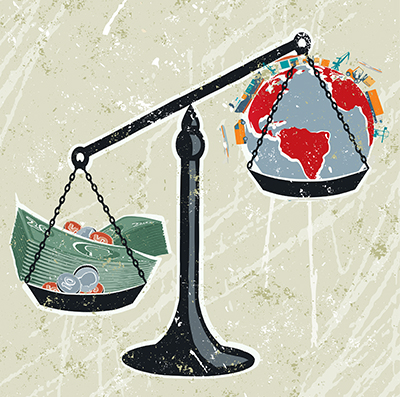Sorry, but your login has failed. Please recheck your login information and resubmit. If your subscription has expired, renew here.
January-February 2018
If you frequent supply chain conferences, as I do, you’ve probably noticed that some of the best-attended sessions are the ones that focus on emerging technologies—or what we’re calling the NextGen Supply Chain. You may have noticed something else: While topics like Big Data, artificial intelligence, augmented reality, blockchain and robotics play to standing room audiences, there’s a lot of confusion about what to do with the information. At the 2016 APICS conference, one member of the audience asked a direct question at the end of an excellent session on Big Data by Hannah Kain, the CEO of Alom: “This sounds great. But there’s not a… Browse this issue archive.Need Help? Contact customer service 847-559-7581 More options
In just about every episode of Shark Tank at least one of the wealthy investors will ask an aspiring entrepreneur if the deal they’re pitching is scalable. It’s certainly a good question for investors to ask. After all, they want to make their money back as quickly as possible and then sit back as the profits from sales roll in. Of course, that would be hard to do if the business in question needs to pile on costs just in order to increase its market share. In other words, investors like to see a business’ sales revenue grow faster than its costs. This is what they mean by scalable or, more specifically, economies of scale.
The term “economies of scale” is a popular one in the business world. Many, however, use the term incorrectly. Furthermore, many shippers who rely on inbound and outbound transportation to bring in raw materials and distribute their finished goods may not realize the multitude of ways that transportation carriers can achieve “scale.” The good news is that economies of scale can lower a carrier’s average costs and potentially lower the freight rates charged to their shipper customers. The bad news is that economies of scale don’t go on indefinitely. There is a point when average costs will actually rise as scale increases. This is known as diseconomies of scale. Getting this right to maximize your transportation strategy is a balancing act—regardless of the mode or modes of shipping.
How economies of scale affect that balancing act is the subject of this article. We’ll look at the specific costs involved in defining economies of scale and set out three items which are important in the definition. We’ll distinguish between the internal and external sources of economies of scale and diseconomies of scale. Finally, we’ll discuss the various ways “scale” can be achieved by transportation carriers.

This complete article is available to subscribers only.
Log in now for full access or start your PLUS+ subscription for instant access.
SC
MR
Sorry, but your login has failed. Please recheck your login information and resubmit. If your subscription has expired, renew here.
January-February 2018
If you frequent supply chain conferences, as I do, you’ve probably noticed that some of the best-attended sessions are the ones that focus on emerging technologies—or what we’re calling the NextGen Supply Chain.… Browse this issue archive. Access your online digital edition. Download a PDF file of the January-February 2018 issue.In just about every episode of Shark Tank at least one of the wealthy investors will ask an aspiring entrepreneur if the deal they're pitching is scalable. It's certainly a good question for investors to ask. After all, they want to make their money back as quickly as possible and then sit back as the profits from sales roll in. Of course, that would be hard to do if the business in question needs to pile on costs just in order to increase its market share. In other words, investors like to see a business' sales revenue grow faster than its costs. This is what they mean by scalable or, more specifically, economies of scale.
The term “economies of scale” is a popular one in the business world. Many, however, use the term incorrectly. Furthermore, many shippers who rely on inbound and outbound transportation to bring in raw materials and distribute their finished goods may not realize the multitude of ways that transportation carriers can achieve “scale.” The good news is that economies of scale can lower a carrier's average costs and potentially lower the freight rates charged to their shipper customers. The bad news is that economies of scale don't go on indefinitely. There is a point when average costs will actually rise as scale increases. This is known as diseconomies of scale. Getting this right to maximize your transportation strategy is a balancing act—regardless of the mode or modes of shipping.
How economies of scale affect that balancing act is the subject of this article. We'll look at the specific costs involved in defining economies of scale and set out three items which are important in the definition. We'll distinguish between the internal and external sources of economies of scale and diseconomies of scale. Finally, we'll discuss the various ways “scale” can be achieved by transportation carriers.
SC
MR


More Finance
- Looking back at NextGen 2024
- Manufacturing again contracts in October, reports ISM
- NextGen Supply Chain Conference set for October 21-23
- Estée Lauder, Schneider Electric and S&S Activewear to receive NextGen End User awards
- 2024 Robotics Application Conference announces session, speaker lineup
- NextGen Supply Chain Conference announces Solution Provider Award winners
- More Finance
Latest Podcast

 Explore
Explore
Business Management News
- 2024 Warehouse/DC Operations Survey: Technology adoption on the rise
- Benchmarking the complexity of ESG reporting
- Looking back at NextGen 2024
- The Corporate Sustainability Due Diligence Directive
- How to make your CFO a supply chain superfan
- Manufacturing again contracts in October, reports ISM
- More Business Management
Latest Business Management Resources

Subscribe

Supply Chain Management Review delivers the best industry content.

Editors’ Picks





